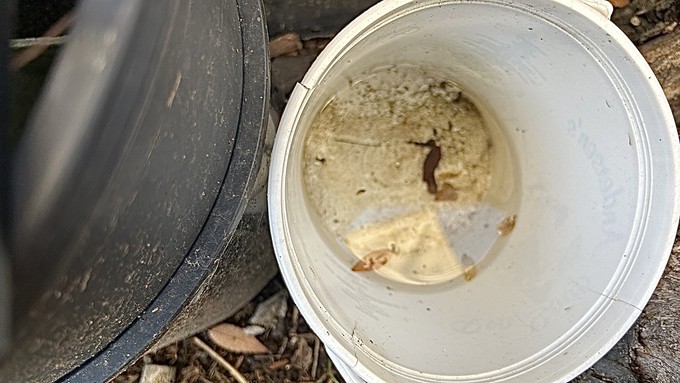
Some trouble spots to look for before Saturday's storm

Oops, something knocked this small bucket to the ground, where it's been collecting water from recent rainstorms. Check around garden equipment as well as plants and drainpipes for water accumulation. Kathy Morrison
It was sunny and bright (and cold!) this morning after Wednesday's clamminess and a bit of rain, but clouds are due to return late this afternoon. And Saturday is expected to be wet, wet, wet all day as another storm rolls in.
There's just enough time walk around the garden for a between-storms checkup. But avoid walking on saturated soil: Stick to sidewalks or stepping stones, if possible. Here's what to look for:
* The last few storms likely showed where the low spots are in your landscape. Mark them with a stick, to remember where they are when the landscape dries out. Or if dogs or people might remove the stick, take a photograph of the location. Especially note to avoid planting anything in that spot that requires good drainage. Here's a link to an earlier post on garden problems that develop -- including crown rot -- when soil gets too much water.
* Depending on the size and location of puddles, you could hoe a temporary drainage ditch away from them or add some garden soil to soak up the water. Don't pack it, however.
* Consider soggy spots for a rain garden, where water can naturally percolate into the ground to irrigate the landscape.
* Make sure storm drains, gutters and downspouts are clear of leaves, sticks and other debris.
* Even better, take a walk around the block and, with a stick or a plant stake, push leaves away from the gutter drains just enough so water won't back up there. Help the neighborhood avoid flooding.
* While you're at it, make sure your downspouts aren't dumping too much water close to the house or garage. Extend the downspouts away from the house and foundation. Ideally, extensions should take rainwater at least 10 feet away from the house. (Read our earlier post on solutions to drainage problems.)
* Tip excess water out of containers. Make sure potted plants aren’t waterlogged, especially succulents, which can turn mushy and even collapse under the influence of excess water and near-freezing winter temperatures.
* Another container check: Are there so many leaves on the soil surface that raindrops can't get through to the soil and the plant's roots? (They're probably draining down the sides or -- eek! -- not draining at all.) Some leaves are OK, but not when they create an organic tarp.
* Eliminate standing water that may have accumulated in wheelbarrows, saucers, piles of unused pots, etc.
* Not everything got watered by the rain. Check plants under patios, eaves and overhangs; they may need a drink.
* Turn off any sprinklers which might still be on. Avoid automatic irrigation for now.
* Search for and pick up large twigs or branches that have fallen or been blown out of trees, especially ones that have landed on top of tender plants. Also, look up into the trees to see if there are other loose branches within reach that you can pull down.
-- Kathy Morrison and Debbie Arrington
Comments
0 comments have been posted.Sacramento Digs Gardening to your inbox.
Food in My Back Yard Series
May 6: Maintain soil moisture with mulch for garden success
April 29: What's (already) wrong with my tomato plants?
April 22: Should you stock up on fertilizer? (Yes!)
April 15: Grow culinary herbs in containers
April 8: When to plant summer vegetables
April 1: Don't be fooled by these garden myths
March 25: Fertilizer tips: How to 'feed' your vegetables for healthy growth
March 18: Time to give vegetable seedlings some more space
March 11: Ways to win the fight against weeds
March 4: Potatoes from the garden
Feb. 25: Plant a fruit tree now -- for later
Feb. 18: How to squeeze more food into less space
Feb. 11: When to plant? Consider staggering your transplants
Feb. 4: Starting in seed starting
Sites We Like
Garden Checklist for week of May 11
Make the most of the lower temperatures early in the week. We’ll be back in the 80s by Thursday.
* Plant, plant, plant! It’s prime planting season in the Sacramento area. Time to set out those tomato transplants along with peppers and eggplants. Pinch off any flowers on new transplants to make them concentrate on establishing roots instead of setting premature fruit.
* Direct-seed melons, cucumbers, summer squash, corn, radishes, pumpkins and annual herbs such as basil.
* Harvest cabbage, lettuce, peas and green onions.
* In the flower garden, direct-seed sunflowers, cosmos, salvia, zinnias, marigolds, celosia and asters. (You also can transplant seedlings for many of the same flowers.)
* Plant dahlia tubers.
* Transplant petunias, marigolds and perennial flowers such as astilbe, columbine, coneflowers, coreopsis, dahlias, rudbeckia and verbena.
* Keep an eye out for slugs, snails, earwigs and aphids that want to dine on tender new growth.
* Feed summer bloomers with a balanced fertilizer.
* For continued bloom, cut off spent flowers on roses as well as other flowering plants.
* Add mulch to the garden to maintain moisture. Mulch also cuts down on weeds. But don’t let it mound around the stems or trunks of trees or shrubs. Leave about a 6-inch-to-1-foot circle to avoid crown rot or other problems.
* Remember to weed! Pull those nasties before they set seed.
* Water early in the day and keep seedlings evenly moist.